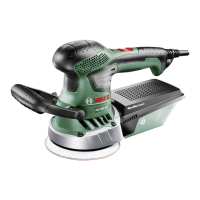14 | English
1 609 92A 1PF | (13.6.16) Bosch Power Tools
Assembly
Before any work on the machine itself, pull the mains plug.
Selecting the Sanding Sheet
Select a sanding sheet with the appropriate grain as required for the desired surface removal rate. Bosch sanding sheets are suit-
able for paint, wood and metal.
Replacing the Sanding Sheet (see figures A–B)
To remove the sanding sheet 7, lift it from the side and pull it
off of the sanding plate 4.
When attaching a new sanding sheet, remove any dust or de-
bris from the sanding plate 4, e. g., with a brush.
The surface of the sanding plate 4 is fitted with Velcro backing
for quick and easy fastening of sanding sheets with Velcro ad-
hesion.
Press the sanding sheet 7 firmly against the bottom side of
the sanding plate 4.
To ensure optimum dust extraction, pay attention that the
punched holes in the sanding sheet match with the holes in
the sanding plate.
The alignment aid 8 can be used for alignment of the sanding
sheet 7 on the sanding plate 4. Place the sanding sheet with
the Velcro facing upward on the alignment aid. Press the cams
of the alignment aid into two holes of the sanding plate and
roll off the sanding sheet from the alignment aid. Press the
sanding sheet firmly against the sanding plate.
Selection of the Sanding Plate
Depending on the application, the machine can be equipped
with sanding plates of different hardness:
– Sanding plate, medium (black): Suitable for all sanding
work; universally usable.
– Sanding plate, soft (grey, accessory): Suitable for interme-
diate and fine sanding, incl. on convex surfaces.
Replacing the Sanding Plate (see figures C–D)
Note: Replace a damaged sanding plate 4 immediately.
Pull off the sanding sheet or the polishing accessory. Unscrew
the four screws 9 completely and remove the sanding plate 4.
Clean the upper side of the new sanding plate 4. Apply a thin
coat of synthetic grease to the outer ring hatched grey in the
figure.
Attach the new sanding plate 4 and tighten the four screws
again.
Note: A damaged sanding-plate base 10 may be changed only
by an authorised after-sales service agent for Bosch power
tools.
Dust/Chip Extraction
Dusts from materials such as lead-containing coatings,
some wood types, minerals and metal can be harmful to
one’s health. Touching or breathing-in the dusts can cause
allergic reactions and/or lead to respiratory infections of
the user or bystanders.
Certain dusts, such as oak or beech dust, are considered
as carcinogenic, especially in connection with wood-treat-
ment additives (chromate, wood preservative). Materials
containing asbestos may only be worked by specialists.
– As far as possible, use a dust extraction system suitable
for the material.
– Provide for good ventilation of the working place.
– It is recommended to wear a P2 filter-class respirator.
Observe the relevant regulations in your country for the mate-
rials to be worked.
Prevent dust accumulation at the workplace. Dusts can
easily ignite.
Operational area Application Grain size
Removal
(coarse sanding)
– Coarse sanding down with high
material removal
– Removal of old paint
– Sanding old paint, varnish and filler extra coarse 40
– Removal of thin coats
– Pre-sanding rough, unplaned surfaces
coarse 60
Preparation
(intermediate
sanding)
– Light sanding down
– Light sanding of surfaces for
continued processing
– Face sanding and planing of irregularities
– Removing score marks from coarse-sanding
medium 80
– Evening out/touching up before applying
paint/varnish
fine 120
Fine Sanding
– Intermediate varnish sanding
– Light sanding of coating de-
fects
– Removal of fibres from surfaces
– Fine sanding before staining or glazing
very fine 180
– Light sanding of primer prior to coating extra fine 240
OBJ_BUCH-1336-004.book Page 14 Monday, June 13, 2016 11:28 AM

